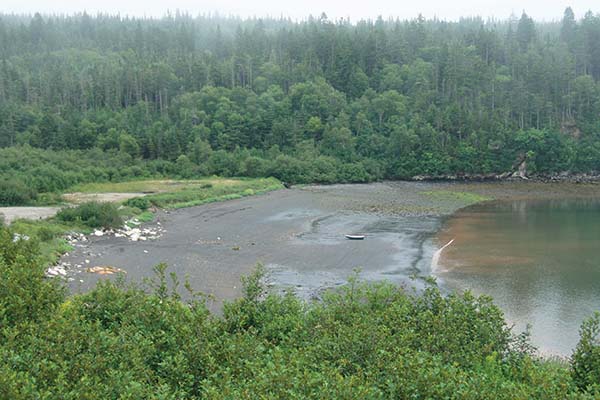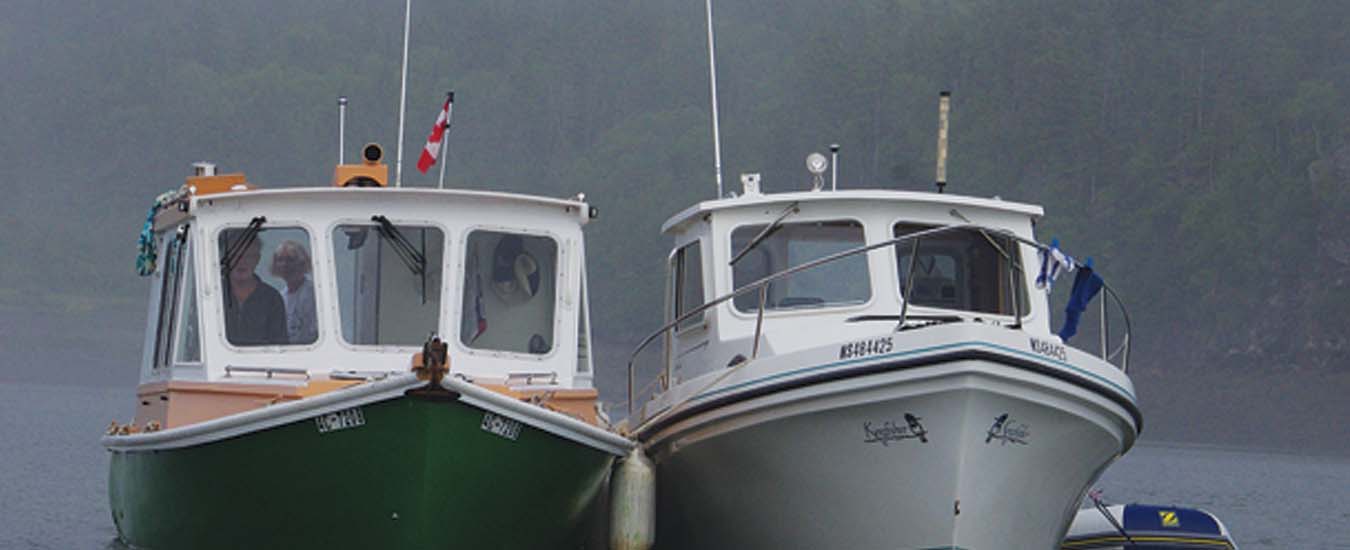The best laid (boating) plans
After two idyllic summers on the lovely, sheltered waters of the lower Saint John River, my wife and I thought a Bay of Fundy excursion would be an exciting, different boating adventure.
And so it was. Not quite as planned, though.
One calm Monday morning in late July, Alice and I departed from Gagetown Marina in our boat, the Kingfisher. We traveled downriver in tandem with our good friends, Tony and Janet Ratliffe, in their boat, the Thomas Gage.
It was a beautiful, inland summer day. Passing by Gorham’s Bluff at 1pm, the air was 28.9° C (84° F), and a light breeze barely ruffled the warm 24° C (75° F) water.
Our boats were well-provisioned for a multi-day trip. We pit-stopped at the Saint John Marina in late afternoon to fuel up before finding a sheltered overnight anchorage at McCormack Cove, on Kennebecasis Island. Rafting together for supper, we watched loons into the evening, while the ethereal songs of a hermit thrush floated across the water. Alarm clocks set, we drifted off to sleep. Life was good.
We pulled anchor at 7am on a clear Tuesday morning, but a fog bank hung low over the city of Saint John. At 8am we powered through the Reversing Falls on a slack tide, following the low tide. We became enshrouded in fog. With reflectors but no active radar equipment, we navigated by GPS, charts, peering carefully through the “soup” and proceeding slowly.
Soon we were beside the commercial shipping lane, then an anchor zone. A dark shadow in the fog gradually metamorphosed into what Janet called a “cliff of steel”; a monster cargo ship that was underway.
The marine forecast predicted the fog would burn off, giving us an afternoon of sun and a light breeze. Perfect! We set a course out into the bay to avoid the strong currents around Point Lepreau. By noon the fog had lifted and the sun was shining. We happily cruised towards Passamaquoddy Bay, our destination. Our boats swayed slowly over gentle swells as we enjoyed the weather’s pleasant turn.
In no time a wind arose from the south. It continued to build. Forty km/hr (25 mph) gusts forced us to angle the boats off-course into three-metre waves. It became a tad exciting. Tony had designed and built the 25-foot Thomas Gage as a river boat with low sides and lots of interior visibility. That layout made it somewhat vulnerable to large waves. Our Newfoundland-built Kingfisher, the same length, had the bow and hull for big waves. The boat and occupants, however, were being slammed around incessantly. The cuddy hatch was quickly closed after water came over the deck. The tenders behind our boats began snapping around. This was serious rock and roll!

Our tender Toby Hind high and dry on Black Beach, Musquash Harbour. Photo credit: Alice Reed
At 3pm the marine weather channel issued a small craft advisory. By this time, we were far from shore. Tony radioed, suggesting that we change our plan and head for the coast. Alice and I quickly agreed.
It was a wild ride to make the shelter of Beaver Harbour. Tying up to a floating dock, we were welcomed by sailing friends from Gagetown, and the harbour master, Nelson MacKenzie. It sure felt good to be warm, safe and no longer being tossed like a salad.
Rain set in overnight, and the wind shifted to easterly. A fog horn serenade ensued. Heavy rain came at daybreak. Fishermen helped us to reposition our boat to face the wind, and kindly asked if we needed anything.
To cope with the high tides, the floating docks were attached by huge metal rings to a series of massive, vertical pylons. The docks sporadically creaked 25 feet up these posts on rising tides, and then slipped quietly back down. Beaver Harbour is a massive, well-maintained and very busy service centre for the local, open-pen salmon aquaculture business.
The next day was wet, foggy, and restful. A moulting male eider duck, bald eagle, great blue heron and a solitary kingfisher patrolled the shoreline. We suited up for a walk on solid ground. Back at the boats, hot tea warmed us up.
Later in the day, an updated marine forecast prompted us to abandon our planned passage to Passamaquoddy Bay in favour of a safer, more leisurely return along the coast towards Saint John.
It was hardly a surprise to wake up on Thursday to heavy fog. There was no wind as we left the harbour. The Kingfisher followed closely behind the Thomas Gage to maintain visual contact, communicating by marine radio as necessary, while dodging floating logs and seaweed mats along the way. Tony, being the senior navigator, piloted us to Musquash Estuary marine protected area, commonly known as Musquash Harbour. We idled in past misty cliffs of jagged rocks, cloaked in a forest of cedars, spruces, maples, birch and ash. A peregrine falcon called as it flew along the craggy bluffs.
By 2pm we’d anchored on an ebbing tide, and rowed ashore in the Ratliffes’ tender, aptly named Toby Hind. The fog lifted over Black Beach, revealing outstanding views of the estuary from the hiking trail along the hillside.
Grey seals came into view on an island called Musquash Ledges in the harbour. When we returned to the beach, as expected, Toby Hind was left high and dry by the retreat of the tide. We lugged the tender across 30 metres of newly exposed sand, launched it and set out for the boats.
Back on the Kingfisher, a little harbour porpoise appeared, followed by several more. Normally shy and wary of boats, the adults were about five feet long. Several were juveniles. It was magical to watch them come up for air with a little huff, and then swim around, just under the surface, hunting for fish.
After the porpoises swam away, I borrowed Tony’s tender and rowed Alice out towards the ledges where the grey seals were congregated. As we approached, the big seals stopped basking and idly swimming; instead they headed straight for us like a football team in possession of the ball. We turned back as a curtain of fog descended once again. We anchored overnight on long lines to accommodate the tide.
Friday morning dawned grey and cool. We left to vibrant loon calls and a fog horn sounding every minute.
Cruising through thick fog, our goal was to reach Saint John harbour to catch the slack tide around 11am. We managed a fine passage upstream through the Reversing Falls after waiting while a procession of sailboats proceeded downstream.
The fog finally began to clear. Soon Alice would no longer need her toque and gloves. We stopped at the Saint John marina for a celebratory lunch. Across Grand Bay, we could see Kennebecasis Island.
Back on the river, we motored by an eagle nest on Long Reach with two youngsters. The sun came out at Caton’s Island as we shed more clothing layers. Continuing upstream, we anchored for the night in Kingston Creek, under picturesque Shamper’s Bluff. Next morning, we headed upstream to our berth at Gagetown Marina.
It was a trip to remember, and a testimony to Fundy’s unpredictable nature. Passamaquoddy Bay is still out there, waiting for us!
